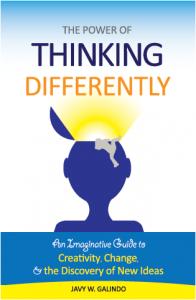In his new book, The Power of Thinking Differently, Galindo lightheartedly explores the roots of our thinking habits and provides an imaginative six-stage roadmap to discovering fresh ideas and implementing creative change. We come to see that creativity isn’t just for creative types. It turns out that we all have the inherent capacity to think creatively and attain creative insights.
Using simple language, the book investigates creativity through the rational lens of psychology, neuroscience, and by looking at popular creative thinking techniques most often used in corporate settings. But this is more than just another book on thinking outside the box. It takes a broad approach to the subject, drawing from the creative process found in art, science, business, everyday living, and spiritual traditions. It also draws from the author’s personal experiences as an engineer, music teacher, and writer—including frequent references to the creative process of writing the book itself.
Also sprinkled throughout are numerous other examples of creativity–the unlikely musical paring of David Bowie and Bing Crosby, Howard Shultz’s inspiration for Starbucks, the Kellog brother’s accidental creation of Cornflakes, and the creativity inherent in good pot of chili to name just a few.
“Access to multiple perspectives opens up possibilities, and reflecting on the creative process itself is no exception,” writes Galindo.
How To Be More Insight Prone
Creative blocks are described to be the results of heightened stress levels. Groupthink is explained in terms of conditioned brain circuitry. So, to overcome creative blocks and re-wire our brains in order to access fresh perspectives, Galindo advocates we learn to relax and joke around.
“In many ways, it’s a state of exaggerated seriousness that causes our inability to access multiple perspectives…Cultivating a sense of humor cultivates the ability to find and hold multiple meanings and multiple perspectives.”
Additionally, there is an emphasis on the need to develop a playful attitude—a trait that was second nature to us when we were children. Galindo stresses this point by examining the creative process of jazz musicians, comedic improvisers, and several innovators including Einstein.
“Creative play is the meat of ingenuity and inventiveness. By actively exploring like children, we can make ourselves more susceptible to the flashes of genius that can help us deal with the scenarios of our adult lives.”
While creativity often seems to be reserved for a gifted few, Galindo writes that this is a common misperception. The latest neuroscience and psychological studies indicate that the brain is built for creativity. What is needed is strong motivation, a clear understanding of the creative process, and a willingness to exercise our creative muscles.
To the latter point, the book is meant to be a bench press for our creative faculties as it interweaves fable, mythology, jokes, and puzzles throughout. In effect, both sides of the brain are exercised upon reading.
Also, woven throughout is a fanciful allegory of an island of pickles and doughnuts that is used to illustrate the absurdity of our habitual thinking patterns.
“Too often we feel unable to change. We react to our circumstances with old, habitual responses…Instead of pure rationality, thinking is predominately governed by habitual pattern recognition.” According to Galindo, we have a biological tendency to make snap judgments based off of assumed meaning and contexts. It is this habit that needs to be broken in order to access flashes of creative insight.
The Creativity Roadmap
The first part of the book describes several popular notions of the creative process (including the notion of the creative genius, lateral thinking, and creativity as a product of the unconscious mind). The second part synthesizes these perspectives into a comprehensive map to discovering creative ideas. The result is a 6-stage model figuratively described as a creative journey.
Amongst other things, the model details ways to overcoming negative thoughts, tools for out-of-the-box thinking, the nature of creative insight, the keys to creativity in groups, and why the creative process isn’t just a right-brain affair.
“It is not enough to have a great idea; the great idea must come into fruition for it to be a creation…after the (right-hemisphere) has formed an association that sparked a moment of insight, (the left-hemisphere) must now evaluate the insight, articulate it, and manifest it.”
The Power of Thinking Differently is a groundbreaking book on the creative process: part how-to-manual, part motivational text, and part fantasy adventure. By investigating the nature of our common sensibilities and our ability for creative thoughts, it successfully shows us how we can be creative in all aspects of our lives. Maybe more importantly, we learn how to view the world with a more meaningful lens—one that opens up our access to creative possibilities and moves the spirit of imagination that enchanted the world when we were children.


